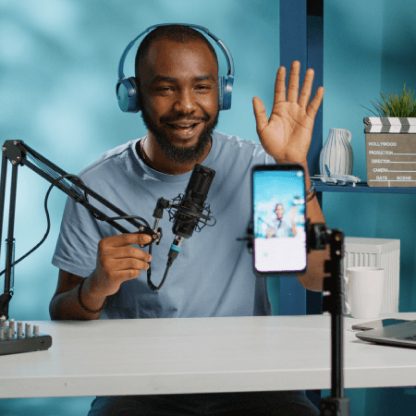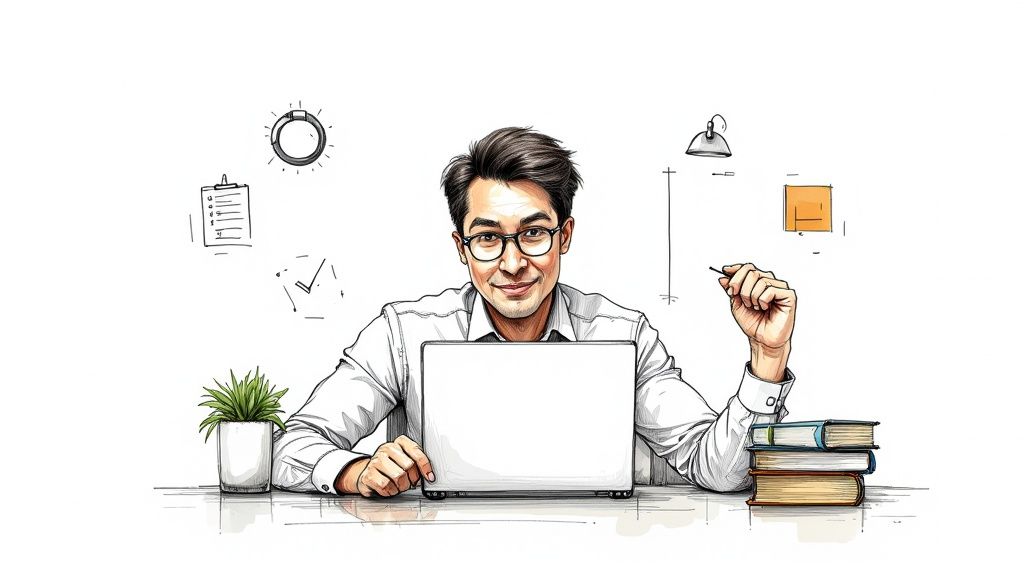So, what exactly is a digital interview? Let’s cut through the noise. Simply put, a digital interview is any job interview that happens remotely using technology, rather than in a traditional face-to-face setting. It’s the modern way for companies to connect with candidates from anywhere in the world, giving everyone involved a lot more flexibility.
What Is a Digital Interview, Anyway?
At its heart, a digital interview uses video to close the distance between a recruiter and a job seeker. Think of it as the next step up from the old-school phone screen, but supercharged with the visual cues and deeper connection you get from seeing someone face-to-face. This isn’t just some passing trend; it has become a core part of how companies find talent today.
In fact, digital interviews are now the go-to method for many, with over 50% of employers worldwide conducting interviews online. This shift was kicked into high gear by the need for remote hiring and the rise of one-way video interviews, where candidates record answers to preset questions on their own schedule.
For businesses, figuring out how HR professionals can host engaging virtual interviews is crucial. It’s not just about pointing a camera and hitting record; it’s about creating an experience that’s smooth, professional, and positive for the candidate.
The Two Main Types of Digital Interviews
The term “digital interview” isn’t a one-size-fits-all concept. It really breaks down into two main flavors: synchronous (live) and asynchronous (pre-recorded). Each one plays a different role in the hiring process.
- Live Digital Interviews: This is the one most people are familiar with. It’s a real-time video call, usually on a platform like Zoom or Google Meet, where you have a live conversation with a hiring manager or a panel. It works just like an in-person interview, just over the internet.
- Pre-Recorded Digital Interviews: This format is a bit different. The company sends you a link with a set of questions, and you record your video answers on your own time, as long as you meet the deadline. It’s less of a back-and-forth chat and more like a prepared presentation of your skills and personality.
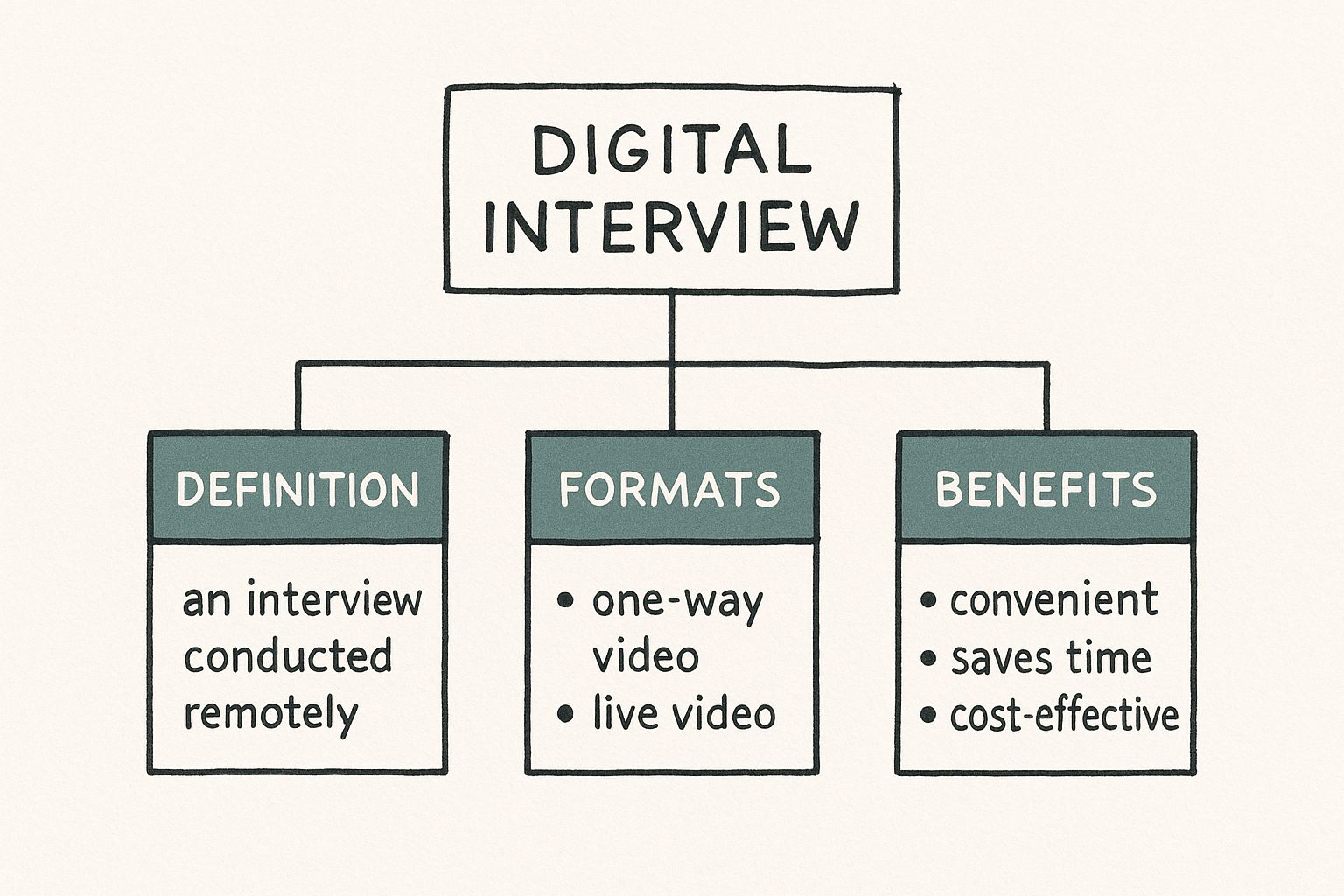
To help you get a better handle on these formats, let’s break down the key differences in a quick comparison.
Live vs Pre-Recorded Digital Interviews at a Glance
This table highlights what to expect from both live and pre-recorded interviews, so you’re never caught off guard.
| Feature | Synchronous (Live) Interview | Asynchronous (Pre-Recorded) Interview |
|---|---|---|
| Interaction | Real-time, two-way conversation with the interviewer. | One-way recording; no live interaction. |
| Scheduling | Requires coordinating a specific time that works for both you and the interviewer. | Flexible; you record your answers on your own schedule before a deadline. |
| Questions | Dynamic and conversational; can include follow-up questions based on your answers. | Pre-set, standardized questions that are the same for all candidates. |
| Environment | Feels more like a traditional interview with immediate back-and-forth. | More like a presentation; you have time to think and prepare your answers. |
| Pressure | On-the-spot thinking is required. | Less pressure to answer instantly, but you need to be self-motivated. |
| Common Use | Later stages of the hiring process for in-depth discussion and cultural fit. | Early screening stages to efficiently evaluate a large number of candidates. |
Both live and pre-recorded formats are tools that help create a more efficient and flexible hiring process for modern companies. Getting comfortable with both is your first step to really shining in this new interview environment.
Understanding Live vs. Pre-Recorded Interviews
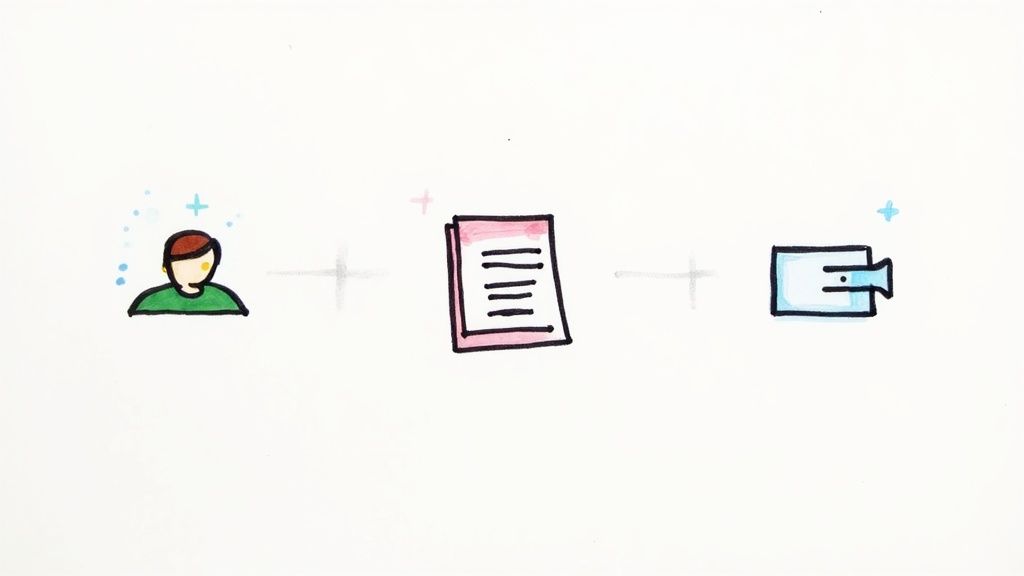
While both live and pre-recorded formats get bundled under the “digital interview” umbrella, they’re worlds apart in practice. Think of it like a live concert versus a studio album. Both feature the same artist, but the experience, the energy, and the preparation are completely different.
Knowing the flow and feel of each type is key to adapting your strategy and showing up as your best self. Let’s break down the mechanics of both, so you know exactly what to expect.
A live digital interview is exactly what it sounds like: a direct, virtual replacement for a face-to-face meeting. It’s a scheduled, real-time conversation over video where you’ll interact with one or more interviewers.
A pre-recorded interview, on the other hand, is a whole different ballgame. It’s less of a two-way conversation and more like a solo performance you’re creating for an audience to watch later.
The Live Interview Workflow
If you’ve ever jumped on a Zoom or Google Meet call with friends or coworkers, the process for a live interview will feel very familiar. It’s what we call a synchronous event, meaning everyone has to be there at the same time.
- The Invitation: It starts with an email containing a specific date and time for the interview. This email will have a link to join the meeting, usually on a platform like Zoom, Google Meet, or Microsoft Teams.
- The Interaction: At the scheduled time, you click the link and enter a virtual room with your interviewer(s). The conversation flows just like an in-person one, with questions, answers, and follow-up discussions happening in the moment.
- The Goal: The main objective here is to build genuine rapport. That back-and-forth dialogue lets your personality shine through, and it’s your chance to ask questions and see if the company culture feels right for you.
This format really tests your ability to think on your feet and hold a dynamic, professional conversation. It’s all about making a human connection.
The real power of a live interview is its immediacy. It allows for the spontaneous, human moments—a shared laugh, a thoughtful pause, a clarifying question—that build a genuine connection between a candidate and a hiring manager.
Because it’s a live conversation, the pressure is on to respond thoughtfully without long, awkward pauses. Preparation is crucial, but so is your ability to stay flexible and just go with the flow of the discussion. This is your chance to show not just what you know, but how you communicate.
The Pre-Recorded Interview Workflow
A pre-recorded, or asynchronous, interview flips the script completely, focusing on flexibility and standardization. You won’t find a live interviewer on the other end of the screen.
Your journey starts with an email invitation, but instead of a meeting time, it will give you a unique link to the interview platform and a deadline. This deadline might be several days out, giving you plenty of time to get ready.
- Step 1: Accessing the Questions: After clicking the link, you’ll usually go through a quick setup to test your camera and microphone. Then, you’ll be shown the first question, often presented in both text and video format.
- Step 2: Recording Your Answer: Here’s where it gets interesting. The platform will give you a set amount of time to think about your response (say, 30-60 seconds) and then a maximum time to actually record it (maybe 2-3 minutes). You record your answer right there in the platform.
- Step 3: Submitting the Interview: You’ll move through the questions one by one, recording a new answer for each. Some platforms might let you re-record an answer a limited number of times, while others are one-and-done. Once you’ve answered everything, you submit the complete interview for the hiring team to review on their own time.
This method gives recruiters a way to evaluate every candidate on the exact same set of questions, which creates a more consistent and fair screening process. For you, the candidate, it takes away the stress of scheduling and lets you answer questions without the pressure of a live audience. Your communication needs to be crystal clear, concise, and totally self-driven.
If you’ve recently been asked to do an interview on camera instead of in an office, you’re probably wondering why. Getting inside the company’s head gives you a strategic edge because you understand the purpose behind the process. This shift isn’t just about new tech; it’s a fundamental change in how businesses find people.
For companies, it all boils down to two things: efficiency and access. Let’s be honest, traditional hiring can be a real slog. It’s slow and bogged down in administrative tasks. Trying to schedule in-person meetings with a dozen candidates and three internal managers creates a logistical nightmare of back-and-forth emails and calendar Tetris.
A digital interview, especially the pre-recorded kind, completely shatters those old limitations. It allows hiring teams to screen a much larger group of people in a fraction of the time. Instead of blocking out hours for live calls, a recruiter can watch short, pre-recorded answers whenever they have a spare moment.
The real magic for employers is scalability. A hiring manager can review ten pre-recorded interviews in the time it would take to conduct just one or two traditional phone screens. This dramatically speeds up creating a shortlist.
This newfound speed directly leads to faster hiring. In competitive markets where the best people get snapped up in days, moving quickly is a massive advantage. Companies that can get from application to offer faster are the ones that win.
Expanding the Talent Pool
Beyond just speed, digital interviews tear down geographical walls. A company is no longer stuck hiring only from the pool of people who live within commuting distance. This opens up a global talent pool, letting them find the absolute best person for the job, no matter where they are.
This is a game-changer for specialized roles where the perfect candidate might be in another state or even another country. The ability to connect with anyone with an internet connection means businesses can truly focus on skills over zip codes.
And for you, the candidate, this is a huge plus. It means way more opportunities are open to you without the cost and hassle of traveling for a first-round interview. It levels the playing field, making the job market more about what you know and less about where you live.
Creating a More Standardized and Fair Process
One of the most powerful—and maybe surprising—reasons companies use pre-recorded interviews is to create a fairer process and reduce unconscious bias. In a traditional setup, interview experiences can be all over the place. One candidate might get a friendly, chatty interviewer, while the next gets someone who’s rushed and distracted.
A structured digital interview helps fix this by standardizing that first screening step.
- Consistent Questions: Every single candidate gets the exact same questions, presented in the exact same way. This creates an even baseline for comparison, making it easier to evaluate people on their actual merits.
- Structured Evaluation: Recruiters can score answers against a pre-defined rubric, forcing them to focus on the substance of what you’re saying, not just a general “vibe.”
- Collaborative Review: Recordings can be easily and securely shared with the whole hiring team. This lets multiple people weigh in, which almost always leads to a more balanced and thoughtful decision.
This structured approach is a cornerstone of modern talent acquisition. Understanding this system is part of a bigger picture that includes knowing how to hire top talent using systematic, repeatable methods. When you realize that companies use a what is a digital interview process to make things more equitable, you can see it not as an impersonal hurdle, but as a deliberate step designed for fairness.
How to Prepare for Your Digital Interview
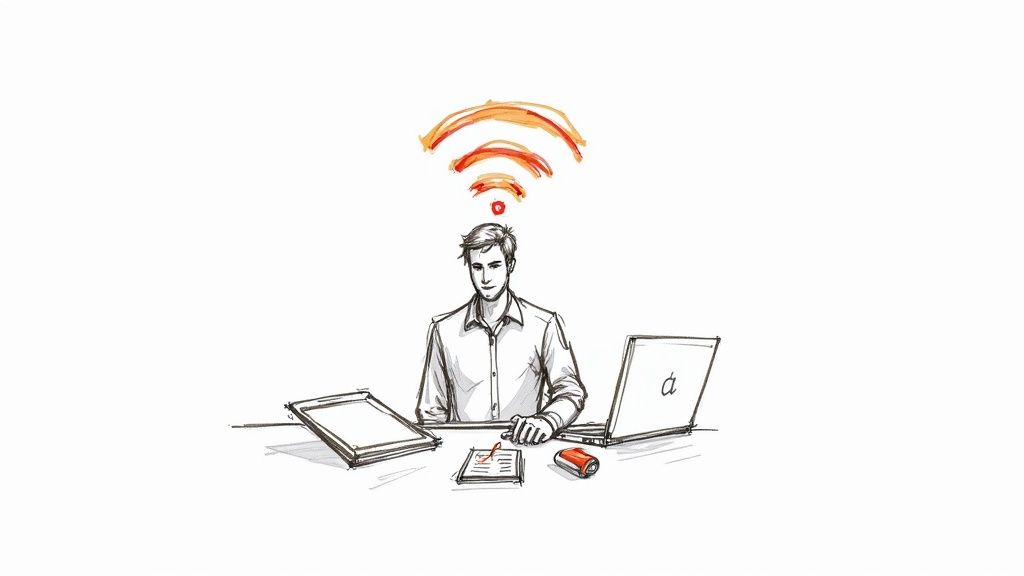
Knowing what a digital interview is doesn’t mean you’re ready to nail it. Far from it. Acing your interview isn’t about luck; it’s about smart preparation. Think of it like a stage performance—the final show is only as good as the rehearsals.
We can break down your prep work into three critical areas: getting your tech and environment right, preparing what you’ll say, and practicing how you look and sound on camera. When you get these three pillars solid, you’ll have the confidence to make a killer first impression.
Master Your Tech and Environment
Technical problems are, hands down, the biggest—and most avoidable—source of stress in a digital interview. You wouldn’t walk into an office with a huge coffee stain on your shirt, right? So don’t show up to a virtual interview with a pixelated camera or a microphone that sounds like you’re in a wind tunnel. A quick tech check is completely non-negotiable.
Your goal here is simple: create a seamless, professional experience for the person on the other end. That means testing everything well before the interview, not five minutes before you’re supposed to log on.
Your Pre-Flight Tech Checklist:
- Test Your Camera and Microphone: Almost every interview platform has a tool to check your gear. Use it. Make sure your video is sharp and your audio is crisp, with no weird echoes or distracting background hums.
- Check Your Internet Connection: A spotty Wi-Fi signal can torpedo your entire interview. Run a quick speed test, and if you can, plug directly into your router with an Ethernet cable. It’s the most reliable option.
- Set Up Your Background: Your background says more about you than you might think. Go for a clean, simple space. A tidy bookshelf, a plain wall, or a single piece of art works great. Avoid cluttered rooms, unmade beds, or anything too personal.
- Perfect Your Lighting: Bad lighting can make you look exhausted or cast weird shadows. The secret is to have your main light source in front of you, not behind. A simple ring light or even just a desk lamp placed behind your laptop will make a huge difference.
Here’s a common mistake: sitting with a window behind you. This instantly turns you into a dark silhouette, making it impossible for the interviewer to see your facial expressions and build a real connection. Always face the light.
Seriously, taking just 15 minutes to run through this checklist can prevent 99% of technical disasters. It signals to the interviewer that you’re a pro who pays attention to the details and takes the opportunity seriously.
Prepare Your Content and Answers
Once the tech is handled, it’s time to focus on what you’re actually going to say. Just like any other interview, you’ve got to do your homework. But for a digital interview—especially a pre-recorded one—structuring your thoughts is even more vital since you can’t rely on conversational back-and-forth.
Your preparation here has three key parts: researching the company, figuring out likely questions, and structuring your answers for real impact.
First, do a deep dive into the company. Scour their website, check out recent news, and see what they’re posting on social media. Get a feel for their mission, their values, and their current projects. Then, connect what you learn back to the role you want.
Next, anticipate the questions. Get ready for common behavioral questions like, “Tell me about a time when…” by having a clear framework for your stories.
The STAR method is a simple but incredibly powerful tool for this:
- Situation: Briefly set the scene. Where and when did this happen?
- Task: What was your goal or responsibility?
- Action: Describe the specific steps you personally took to handle it.
- Result: Share the outcome. Use numbers and concrete results whenever you can to show your impact.
A framework like STAR stops you from rambling and keeps your answers tight, relevant, and persuasive. For even more detailed guidance, check out our pro tips for mastering your on-demand video interview to ensure your answers hit the mark.
Practice Your On-Camera Delivery
Finally, you need to practice how you come across on screen. Talking to a tiny camera lens is a completely different skill than talking to a person across a table. What feels natural face-to-face can look stiff or awkward on video.
The single most important tip is to look directly at the camera lens, not at your own face or the interviewer’s image on the screen. This creates the digital version of direct eye contact, which is essential for building rapport and showing confidence. It feels strange at first, but it makes all the difference to the viewer.
Do a few practice runs. Use your phone to record yourself answering a few common interview questions. Then, watch the playback. Pay attention to your body language, your tone, and your pacing. Are you talking a mile a minute? Fidgeting? Do you look engaged and friendly?
This kind of self-critique is priceless. It lets you spot and fix any bad habits before the real thing, ensuring that when the time comes, you appear polished, confident, and absolutely ready for the role.
The Rise of AI in the Interview Process
Welcome to the next frontier in hiring. As digital interviews become the norm, companies are starting to bring artificial intelligence (AI) into the mix to make the whole process more efficient and data-driven. It might sound like something out of a sci-fi movie, but this technology is already changing how candidates are evaluated.
This shift is often part of a concept called Interview as a Service (IaaS). You can think of it as a toolkit that adds AI-powered features on top of the digital interview process. These tools might help automate scheduling, give recruiters real-time analytics, and even help reduce bias during the early screening stages.
But this isn’t about letting robots make the final call. Far from it. Instead, AI works as an assistant to human recruiters, giving them extra data points to help them make better, more informed choices.
How AI Assists in Digital Interviews
So, what does this actually look like in practice? It’s pretty straightforward. An AI tool might scan your recorded interview responses for specific keywords that match the job description, or it might analyze your tone of voice for enthusiasm. Some can even evaluate your on-camera engagement.
It’s important to understand what the goal is here. The main reason for using AI is to add a layer of objectivity and help recruiters sort through a large number of applicants more effectively. By focusing on consistent data points for everyone, companies hope to minimize the natural human biases that can sneak into hiring, making sure every candidate gets a fair shot.
The role of AI in interviews is not to replace human judgment but to augment it. These tools are designed to filter for relevance and qualifications, allowing human recruiters to focus their time and energy on the most promising candidates.
The whole idea is to give you a better, more objective way to showcase your skills to a wider range of potential employers.
A Reassuring Look at AI in Hiring
The thought of an algorithm analyzing your interview can be a little intimidating, but it really doesn’t have to be. Your best bet is to just be yourself—authentic and confident. The AI is simply programmed to look for the same signals of qualification and engagement that a human recruiter would, just in a more structured way.
- Focus on Clarity: Speak clearly and try to use language that directly connects your experience to the job requirements. This helps the AI system (and the human reviewer) easily pick up on your relevant skills.
- Show Enthusiasm: Your energy and tone of voice matter. An AI might interpret vocal variety as a sign of genuine interest, so don’t be afraid to let your personality shine through.
- Stay Engaged: Keep good on-camera posture. Look into the camera lens and use positive body language. This signals confidence to both the AI and the hiring manager who will watch the recording later.
At the end of the day, these are the same things that make for a great interview, whether there’s AI involved or not. If you want to learn more about how technology is changing hiring, you can explore resources on AI hiring and intelligent assessment.
And remember, the fundamental rules of making a great impression still apply. You can get up to speed by checking out our essential virtual interview tips. Think of AI as just one more tool in the modern recruiter’s belt, one that’s designed to make hiring fairer and more efficient for everyone involved.
Common Mistakes That Can Cost You the Job
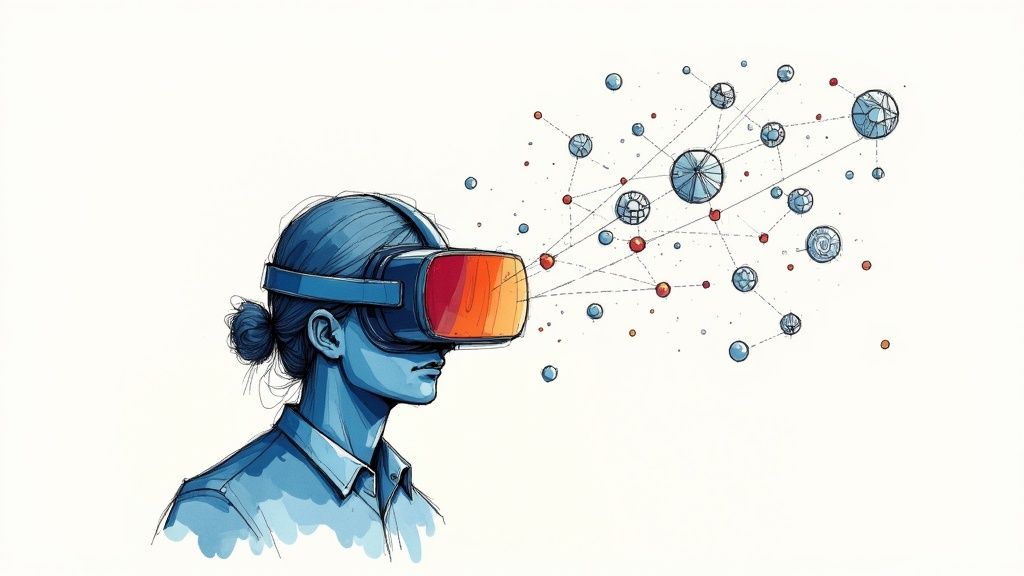
You can be a fantastic candidate on paper, but a few simple, avoidable mistakes can derail your chances in a digital interview. Think of it this way: your interview has two equally important parts. There’s your professional expertise, and then there’s your technical presentation. Even the sharpest answers can fall completely flat if they’re delivered through a blurry camera or crackling audio.
Knowing the common pitfalls is the first step to sidestepping them entirely. The goal is to make the hiring manager remember you for your incredible skills, not for a choppy Wi-Fi signal or a distracting background. This is your guide to avoiding those easy-to-make errors.
Technical and Environmental Blunders
Ironically, the mistakes we see most often are the easiest to fix with a little prep. These technical and environmental slip-ups can signal a lack of attention to detail and, frankly, create a frustrating experience for the interviewer.
We’ve all heard the cautionary tales. There’s the candidate whose internet keeps dropping, forcing multiple reconnections and completely killing the conversational flow. Or the one who sounds like they’re shouting from across the room because their microphone isn’t set up correctly.
Here are the most common technical mistakes and how to fix them:
- Don’t: Assume your technology will just work on the day.
- Do: Test your camera, microphone, and internet connection at least 30 minutes before the interview. Most platforms have built-in tools to help you do this. Use them.
- Don’t: Sit in a dark room or with a bright window directly behind you.
- Do: Find a light source, like a lamp or a window, and position it in front of your face. This ensures you’re clearly visible and helps the interviewer connect with you.
- Don’t: Have a cluttered or distracting background.
- Do: Choose a neutral, professional setting. A clean wall, a tidy bookshelf, or even a simple virtual background works perfectly. Remember, your environment is an extension of your professional image.
Your digital interview space is your stage. If the lighting is poor or the sound is muffled, it’s like trying to watch a play from behind a curtain. The performance, no matter how good, simply won’t land.
Personal and Preparation Oversights
Beyond the tech setup, how you prepare and present yourself is just as critical. These are the mistakes that can make you seem robotic, unprepared, or just plain disinterested—undermining the very connection you’re trying to build.
One of the absolute worst things you can do is read your answers from a script. It immediately makes you sound unnatural and disengaged. You’re aiming for a conversation, not a recitation. In a similar vein, dressing unprofessionally (yes, even from the waist up) shows a lack of respect for the opportunity.
Common Personal Mistakes to Avoid:
- Reading From a Script: It’s smart to have a few bullet points nearby for reference, but never read full sentences. This kills any chance of building genuine rapport and makes real eye contact with the camera impossible.
- Dressing Unprofessionally: Treat a digital interview exactly like you would an in-person one. Dressing in professional attire shows you’re taking this seriously.
- Failing to Follow Up: A simple thank-you email sent within 24 hours is a must. It’s a small step that reinforces your interest and professionalism, leaving a lasting positive impression that keeps you top of mind.
Answering Your Last-Minute Digital Interview Questions
Even after you’ve prepared for days, it’s completely normal for a few last-minute questions to pop into your head right before a digital interview. We get it. That’s why we’ve put together this quick FAQ section to tackle the most common worries we hear about.
Let’s clear up everything from what to wear to how to handle a tech meltdown so you can walk in (or log on) feeling confident and ready.
What Should I Wear for a Digital Interview?
The simplest rule of thumb is to dress exactly as you would for an in-person interview with that company. This usually means business casual or something more formal. At the very least, make sure your outfit is professional from the waist up.
Stick to solid, neutral colors like blue, gray, or black—they always look sharp on camera. It’s best to avoid busy patterns, bright neon colors, or large, flashy jewelry, as they can be distracting and sometimes create weird visual effects on screen.
Is It Okay to Use Notes During the Interview?
Yes, it’s perfectly fine to have a few notes nearby, but you absolutely want to avoid reading from a script. The idea is to sound natural and conversational, not like you’re delivering a pre-written speech. Your notes are there to be a safety net, not a crutch.
Pro Tip: Try placing your notes on a small sticky note right next to your webcam. This trick lets you glance at your key points while still making it look like you’re maintaining great eye contact with the interviewer.
Keep your notes brief—just a few bullet points to jog your memory on specific results or questions you want to ask.
What if My Internet Fails Mid-Interview?
First off, take a breath. Don’t panic—tech issues happen to everyone. If you’re in a live interview, your first move should be to try and rejoin the meeting right away. If that doesn’t work, immediately send an email or call your contact person to explain the situation and ask about rescheduling.
For pre-recorded interviews, most platforms are built to save your progress automatically. You can usually just log back in and pick up right where you left off. The key is to communicate proactively. Handling a technical glitch with calm professionalism shows you can solve problems under pressure.
The move to digital interviewing isn’t just a trend; it’s backed by huge growth in digital connectivity worldwide. With mobile video and AI tools getting better all the time, it’s no shock that over half of all job interviews globally now happen on online platforms. You can read more about these global digital trends to see the bigger picture.
As you get ready, just remember that practice makes a huge difference. For more ideas on what to expect, take a look at our helpful article on common video interview questions.
Ready to make your hiring process faster and more efficient? Async Interview automates initial screenings, helping you find top talent up to ten times faster. Start your free trial today and see the difference.
